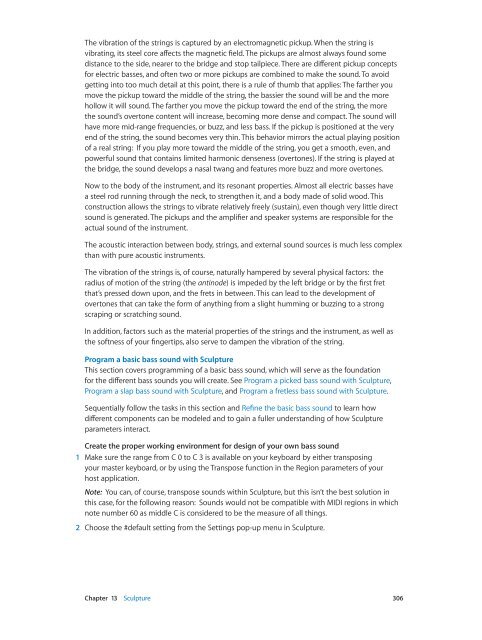Apple MainStage 3 Instruments - MainStage 3 Instruments
Apple MainStage 3 Instruments - MainStage 3 Instruments
Apple MainStage 3 Instruments - MainStage 3 Instruments
Create successful ePaper yourself
Turn your PDF publications into a flip-book with our unique Google optimized e-Paper software.
The vibration of the strings is captured by an electromagnetic pickup. When the string is<br />
vibrating, its steel core affects the magnetic field. The pickups are almost always found some<br />
distance to the side, nearer to the bridge and stop tailpiece. There are different pickup concepts<br />
for electric basses, and often two or more pickups are combined to make the sound. To avoid<br />
getting into too much detail at this point, there is a rule of thumb that applies: The farther you<br />
move the pickup toward the middle of the string, the bassier the sound will be and the more<br />
hollow it will sound. The farther you move the pickup toward the end of the string, the more<br />
the sound’s overtone content will increase, becoming more dense and compact. The sound will<br />
have more mid-range frequencies, or buzz, and less bass. If the pickup is positioned at the very<br />
end of the string, the sound becomes very thin. This behavior mirrors the actual playing position<br />
of a real string: If you play more toward the middle of the string, you get a smooth, even, and<br />
powerful sound that contains limited harmonic denseness (overtones). If the string is played at<br />
the bridge, the sound develops a nasal twang and features more buzz and more overtones.<br />
Now to the body of the instrument, and its resonant properties. Almost all electric basses have<br />
a steel rod running through the neck, to strengthen it, and a body made of solid wood. This<br />
construction allows the strings to vibrate relatively freely (sustain), even though very little direct<br />
sound is generated. The pickups and the amplifier and speaker systems are responsible for the<br />
actual sound of the instrument.<br />
The acoustic interaction between body, strings, and external sound sources is much less complex<br />
than with pure acoustic instruments.<br />
The vibration of the strings is, of course, naturally hampered by several physical factors: the<br />
radius of motion of the string (the antinode) is impeded by the left bridge or by the first fret<br />
that’s pressed down upon, and the frets in between. This can lead to the development of<br />
overtones that can take the form of anything from a slight humming or buzzing to a strong<br />
scraping or scratching sound.<br />
In addition, factors such as the material properties of the strings and the instrument, as well as<br />
the softness of your fingertips, also serve to dampen the vibration of the string.<br />
Program a basic bass sound with Sculpture<br />
This section covers programming of a basic bass sound, which will serve as the foundation<br />
for the different bass sounds you will create. See Program a picked bass sound with Sculpture,<br />
Program a slap bass sound with Sculpture, and Program a fretless bass sound with Sculpture.<br />
Sequentially follow the tasks in this section and Refine the basic bass sound to learn how<br />
different components can be modeled and to gain a fuller understanding of how Sculpture<br />
parameters interact.<br />
Create the proper working environment for design of your own bass sound<br />
1 Make sure the range from C 0 to C 3 is available on your keyboard by either transposing<br />
your master keyboard, or by using the Transpose function in the Region parameters of your<br />
host application.<br />
Note: You can, of course, transpose sounds within Sculpture, but this isn’t the best solution in<br />
this case, for the following reason: Sounds would not be compatible with MIDI regions in which<br />
note number 60 as middle C is considered to be the measure of all things.<br />
2 Choose the #default setting from the Settings pop-up menu in Sculpture.<br />
Chapter 13 Sculpture 306
















